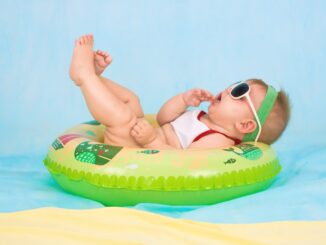
A baby travel system is a combination of essential items for parents of infants, designed to make travelling with a baby more convenient.
Information that is country specific, UK, at bottom of post
It typically includes three main components: a stroller, an infant car seat, and a car seat base. Here are the main features and benefits of a baby travel system:
- Stroller:
- Versatility: Most travel system strollers are designed to be versatile and adaptable. They can accommodate your infant car seat, providing a seamless transition from car to stroller without disturbing your baby.
- Comfort: These strollers often feature padded seats, multiple recline positions, and canopies to keep your child comfortable and protected from the elements.
- Storage: Many strollers come with storage options, such as under-seat baskets, pockets, and cup holders for parents to carry essentials like diapers, bottles, and bags.
- Manoeuvrability: They are designed for easy manoeuvrability, often with swivel front wheels and suspension systems to provide a smooth ride.
- Infant Car Seat:
- Safety: Infant car seats are designed to provide the utmost safety for your baby during car travel. They are rear-facing to protect infants from crashes and collisions.
- Convenience: The car seat can be easily detached from the base in the car and clicked into the stroller, allowing you to move your sleeping baby without waking them.
- Side-Impact Protection: Many car seats come with additional features like side-impact protection and energy-absorbing foam for enhanced safety.
- Car Seat Base:
- Ease of Installation: The car seat base is installed in your vehicle using the LATCH system or seatbelt, making it easy to secure the infant car seat securely.
- Convenience: It allows for quick and secure attachment and detachment of the car seat, eliminating the need to install the car seat each time you drive.
- Travel System Compatibility:
- Click-and-Go: The main feature of a travel system is the ability to easily move your baby from the car to the stroller and vice versa with a simple click-and-go mechanism.
- Interchangeable: Many travel systems are designed to be compatible with multiple car seat models and strollers from the same brand or series, allowing you to adapt the system as your child grows.
- Adjustability and Growth: Some travel systems offer the flexibility to grow with your child, allowing you to convert the stroller to accommodate a toddler as they outgrow the infant car seat.
- Accessories: Many travel systems come with additional accessories like rain covers, parent trays, and child trays, providing added convenience and protection for both parents and baby
Baby Travel System Features :
- Comfort: Travel systems provide more options for your baby’s comfort. For example, the stroller may have multiple modes of use, such as a fully reclined carriage mode for newborns and a toddler seat for older children
- Convenience: Travel systems make it easy to move your baby from the car to the stroller and back again without having to move them in and out of their seat. This is especially helpful when your baby is sleeping or finicky
- Style: Travel systems add a touch of sophistication and style to your everyday routine. Coordinating infant seats and strollers can make you the envy of other parents
- Safety: Travel systems are designed to work together securely, so you can be confident in your infant seat and stroller
- Value: Travel system strollers typically provide the best value for families, as they are cheaper than buying each item individually
Additional features of some travel systems:
- Carrycot: A carrycot is a bassinet-style attachment that can be used with a travel system stroller frame. This allows you to use your stroller as a pram for your newborn baby.
- All-terrain wheels: Some travel systems come with all-terrain wheels, which makes them ideal for use on rough surfaces such as gravel or dirt.
- One-hand fold: Many travel systems can be folded down with one hand, which is helpful for parents who are juggling multiple items.
- Storage basket: Most travel systems have a storage basket underneath the seat, which is perfect for storing diapers, wipes, and other essentials.
When choosing a baby travel system, it’s important to consider the following factors:
- Your budget: Travel systems can range in price from a few hundred dollars to over a thousand dollars. It’s important to set a budget before you start shopping so that you don’t overspend.
- Your lifestyle: If you’re a very active family, you’ll need a travel system that is durable and has all-terrain wheels. If you live in a city, you may want to choose a travel system that is lightweight and easy to fold.
- Your baby’s needs: Consider your baby’s age and size when choosing a travel system. If you have a newborn, you’ll need a system that includes a carrycot. If you have an older baby, you may want to choose a system with a reversible seat so that your baby can face you or the world.
When choosing a travel system, it is important to consider the main features of the stroller, such as the canopy, wheels, and storage options
Different types of 3-in-1 travel systems
There are different types of 3-in-1 travel systems available in the market. Some of the most popular types include:
- Stroller, Car Seat, and Bassinet Combo: This type of travel system includes a stroller, a car seat, and a bassinet that can be used interchangeably
The stroller usually comes with a separate seat that can be used as the baby grows out of the car seat, but the car seat also fits on the stroller chassis.
- High Landscape Reversible Foldable Portable Standard Stroller Newborn Pram Buggy Reclining Baby Carriage: This type of travel system is a combination of a stroller, a car seat, and a bassinet that can be used interchangeably. It is designed to be high landscape, reversible, foldable, and portable, making it perfect for parents who are always on the go.
- Stroller and Car Seat Combo: This type of travel system includes a stroller and a car seat that can be used interchangeably
The car seat usually clicks into place easily on the stroller chassis, making it easy to move your baby from the car to the stroller and back again.
- Stroller and Bassinet Combo: This type of travel system includes a stroller and a bassinet that can be used interchangeably
The bassinet is usually designed to be fully reclined, making it perfect for newborns. The stroller usually comes with a separate seat that can be used as the baby grows.
When choosing a 3-in-1 travel system, it is important to consider factors such as convenience, affordability, versatility, comfort, and style.
It is also important to consider the storage space, manoeuvrability, and car seat longevity of the travel system
Baby Strollers
Benefits of a 3-in-1 Baby Travel System
- Convenience: A 3-in-1 travel system is extremely convenient as it eliminates the need to buy separate strollers, car seats, and bassinets for your child as they grow. It is also easy to assemble and disassemble, making it perfect for travel
- Affordability: 3-in-1 travel systems are more affordable than buying each item separately
They usually come with a lot of features that other systems do not have, such as a built-in changing station
- Versatility: A 3-in-1 travel system gives you the option to use it as a stroller, a car seat, or a bassinet, making it the most versatile and practical choice for parents.
- Comfort: 3-in-1 travel systems are designed with padded seats and ergonomic handles, making them comfortable for both baby and parent. They also provide more options for your baby’s comfort, such as a fully reclined carriage mode for newborns.
- Style: 3-in-1 travel systems add a touch of sophistication and style to your everyday routine. Coordinating infant seats and strollers can make you the envy of other parents.
When considering a 3-in-1 travel system, it is important to consider factors such as storage space, manoeuvrability, and car seat longevity.
Some parents find that they’d rather carry a baby in a backpack carrier or sling than in a stroller or infant car seat
However, a 3-in-1 travel system is a great option for parents who want to be able to transport their child easily and comfortably.
Baby Travel System FAQ
When buying a baby travel system, parents and caregivers often have several questions to ensure they make the right choice for their child’s safety, comfort, and convenience. Here are some of the most common questions people ask when purchasing a baby travel system:
- What is included in the travel system?
- Customers want to know which components are included in the package, typically a stroller, infant car seat, and car seat base.
- Is the car seat compatible with my vehicle?
- This is a crucial consideration to ensure that the car seat can be safely and securely installed in their specific vehicle.
- What is the weight and height limit for the infant car seat?
- Knowing the limits helps parents understand how long the car seat will be suitable for their child.
- Is the travel system easy to assemble and disassemble?
- Convenience is essential, so parents often ask about how easy it is to set up and fold down the travel system.
- Can the car seat be used without the stroller base?
- Some parents want the flexibility to use the car seat independently of the stroller.
- How does the stroller handle different terrains?
- Parents inquire about the stroller’s performance on various surfaces, such as pavement, gravel, and grass.
- Is it easy to manoeuvre the stroller?
- Ease of manoeuvrability is important, especially for navigating tight spaces or crowded areas.
- What safety features are included in the car seat and stroller?
- Customers want to know about harness types, side-impact protection, and other safety features.
- Is the fabric removable and machine washable?
- Parents appreciate easy-to-clean materials, as babies can be messy.
- What accessories are available or included with the travel system?
- Customers may ask about included accessories like cup holders, trays, rain covers, or adapters for attaching other baby gear.
- What is the warranty or return policy for the travel system?
- Knowing the warranty and return policy provides peace of mind in case any issues arise.
- How does the travel system fold down for storage or transport?
- Parents often ask about the folding mechanism and the dimensions when folded to ensure it fits in their car or storage space.
- What is the weight of the stroller and car seat?
- Weight is a concern, as parents need to lift and transport the components.
- Is the travel system compatible with other brands or models of car seats?
- Some parents want to know if they can use a different car seat with the stroller.
- Are there different colour options available?
- Customers may want to choose a colour or design that suits their personal preference.
- What is the price range for the travel system?
- Budget considerations are important, and parents often ask about price ranges and available features within those ranges.
- What are the safety and testing standards that the travel system meets?
- Parents often inquire about the safety certifications and standards that the travel system adheres to.
- How easy is it to clean and maintain the travel system?
- Cleanliness and maintenance are vital for ensuring the system remains safe and functional.
By asking these questions and carefully considering the answers, parents can make an informed decision when selecting a baby travel system that meets their specific needs and preferences.
Pros and Cons of a Stroller Frame vs. a Baby Travel System
Pros:
- Lightweight and Compact: Stroller frames are typically lightweight and easy to manoeuvre. They’re great for quick trips and travel because they’re less bulky than full-size strollers.
- Compatibility: Stroller frames are specifically designed to work with infant car seats, providing a secure fit. This means you don’t have to disturb your sleeping baby when transferring them from the car to the stroller.
- Cost-Efficient: Stroller frames are generally more affordable than full travel systems because they serve a single purpose – carrying an infant car seat.
- Easy to Store: Due to their compact design, stroller frames are easy to store and transport, making them ideal for families with limited storage space.
Cons:
- Limited Use: Stroller frames can only be used with infant car seats, and they are outgrown when your child transitions to a toddler-sized car seat. This means you’ll eventually need to purchase a full-size stroller.
- No Reclining Options: Most stroller frames lack the features and comfort of full-size strollers, such as reclining seats, storage, and canopy options.
Baby Travel System:
A baby travel system typically consists of a stroller and an infant car seat that can be used together as a comprehensive solution for transporting your child. Here are its pros and cons:
Pros:
- Versatility: Baby travel systems provide a stroller that can be used from infancy through toddlerhood. They often have adjustable features like reclining seats, larger canopies, and storage compartments.
- Seamless Transition: Travel systems allow for a seamless transition between the car and the stroller without disturbing your sleeping baby, as the car seat clicks onto the stroller.
- Long-Term Use: You can continue to use the stroller as your child grows, making it a long-term investment.
- Storage and Accessories: Many travel systems come with storage baskets, cup holders, and other accessories to make outings more convenient.
Cons:
- Bulkier and Heavier: Travel systems are typically larger and heavier than stroller frames, making them less convenient for travel or quick trips.
- Cost: Baby travel systems are more expensive upfront than stroller frames, as they include both a stroller and an infant car seat.
- Compatibility Concerns: While travel systems are designed to work together, there may be compatibility issues with certain car seats or strollers, so it’s important to check if your chosen combination is compatible.
In summary, the choice between a stroller frame and a baby travel system depends on your specific needs and preferences. If you want a more budget-friendly, lightweight, and portable option for newborns, a stroller frame may be ideal.
However, if you value versatility and the convenience of a stroller that can grow with your child, a baby travel system may be the better choice. Consider your lifestyle, budget, and long-term needs when making your decision.
How to install a 3-in-1 Baby Travel System
Installing a 3-in-1 travel system involves setting up a combination of a car seat, stroller, and carrycot or bassinet in a way that allows you to seamlessly move your baby between these components.
Here are general steps for installing a 3-in-1 travel system, but make sure to consult the specific manufacturer’s instructions for your particular model, as designs and features may vary:
- Read the Manual: Always start by reading the user manual that comes with your 3-in-1 travel system. This will provide you with detailed instructions specific to your product.
- Assemble the Stroller Frame: If your travel system requires assembly, follow the instructions in the manual to set up the stroller frame. This typically involves attaching wheels, unfolding and locking the frame, and securing the components.
- Attach the Car Seat: If your system includes a car seat, ensure that the base is securely installed in your car following the car seat manufacturer’s instructions. Then, you can typically click the car seat onto the stroller frame using the adapters or attachments provided. Ensure it locks securely in place.
- Attach the Carrycot/Bassinet: If your travel system has a carrycot or bassinet, you can typically attach it to the stroller frame once the stroller is fully set up. The method of attachment will depend on the specific model, but it often involves securing it onto the frame with locking mechanisms or adapters.
- Secure Your Baby: Place your baby in the appropriate component (car seat, bassinet, or stroller seat) and secure them according to the manufacturer’s instructions. Ensure all straps, harnesses, and safety features are used correctly and are snug but not too tight.
- Test for Stability: Once your baby is safely secured in the travel system, give it a gentle push or rock to ensure that it is stable and won’t tip over. Ensure that all components are securely attached.
- Adjust for Comfort: Ensure your baby is comfortable by adjusting the recline angle of the stroller seat or bassinet if applicable. Ensure they have enough head support and are protected from the sun, wind, or rain as needed.
- Practice Folding and Unfolding: Familiarize yourself with how to fold and unfold the travel system for easy transportation and storage. Make sure you can do this easily and quickly when needed.
- Practice Safe Use: Always use the travel system safely. Be cautious when moving your baby in and out of the car seat, stroller, or bassinet. Make sure the stroller brakes are engaged when not in motion, and never leave your baby unattended.
- Regular Maintenance: Keep the travel system clean and periodically check for any signs of wear or damage. Follow the manufacturer’s guidelines for maintenance and cleaning.
Remember, it’s crucial to follow the specific instructions provided by the manufacturer of your 3-in-1 travel system, as different models may have unique installation procedures. Your baby’s safety should always be the top priority when using a travel system.
Safety features of a 3-in-1 Baby Travel System
- Five-Point Harness: Most infant car seats and stroller seats in these systems come with a five-point harness that secures your child at the shoulders, hips, and between the legs. This harness provides a secure fit and minimizes the risk of your child slipping out.
- Side-Impact Protection: Many infant car seats are designed with side-impact protection, which includes energy-absorbing foam and reinforced sides to shield your child from potential side-impact collisions.
- Latch System: The car seat base usually features a LATCH (Lower Anchors and Tethers for Children) system, which allows you to securely install the car seat in your vehicle without using the seat belt.
- Adjustable Recline Positions: Infant car seats often have multiple recline positions to ensure a proper fit for your child. This helps keep your baby’s head in a safe position, especially when they’re unable to hold up their own head.
- Adjustable Canopy: Stroller canopies can protect your child from the sun and elements. A good canopy should be adjustable and provide adequate coverage.
- Lockable Wheels: Stroller wheels should be lockable to prevent unintentional rolling and to keep the stroller stable when stationary.
- One-Hand Fold Mechanism: Strollers should have a reliable one-hand fold mechanism for easy and convenient folding.
- Brakes: Strollers should have effective brakes, often in the form of foot-activated brake pedals, to secure the stroller in place when needed.
- Sturdy Frame: The stroller frame should be sturdy and durable to ensure it can handle the weight of your child without any risk of collapsing or breaking.
- Safety Labels and Instructions: Ensure that you read and follow all safety labels and instructions provided with the travel system. This includes weight and height limits for the car seat and stroller, as well as guidelines for proper installation and use.
- Expiration Date: Infant car seats often have an expiration date, and it’s important to check and adhere to it. Over time, materials may degrade, affecting the seat’s safety.
- Regular Maintenance: Regularly inspect and maintain your travel system, including cleaning, checking for wear and tear, and ensuring that all parts are in good working order.
It’s crucial to choose a 3-in-1 travel system from a reputable manufacturer and follow all safety guidelines and recommendations. Additionally, ensure the system is installed and used correctly to maximize the safety of your child during travel.
For UK Baby Travel System Information, click here



